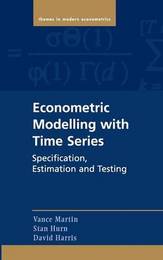
|
Econometric Modelling with Time Series: Specification, Estimation and Testing
Hardback
Main Details
| Title |
Econometric Modelling with Time Series: Specification, Estimation and Testing
|
| Authors and Contributors |
By (author) Vance Martin
|
|
By (author) Stan Hurn
|
|
By (author) David Harris
|
| Series | Themes in Modern Econometrics |
|---|
| Physical Properties |
| Format:Hardback | | Pages:924 | | Dimensions(mm): Height 229,Width 152 |
|
| Category/Genre | Econometrics |
|---|
| ISBN/Barcode |
9780521196604
|
| Classifications | Dewey:330.015195 |
|---|
| Audience | | Professional & Vocational | |
|---|
| Illustrations |
97 Tables, unspecified; 104 Line drawings, unspecified
|
|
Publishing Details |
| Publisher |
Cambridge University Press
|
| Imprint |
Cambridge University Press
|
| Publication Date |
28 December 2012 |
| Publication Country |
United Kingdom
|
Description
This book provides a general framework for specifying, estimating and testing time series econometric models. Special emphasis is given to estimation by maximum likelihood, but other methods are also discussed, including quasi-maximum likelihood estimation, generalised method of moments estimation, nonparametric estimation and estimation by simulation. An important advantage of adopting the principle of maximum likelihood as the unifying framework for the book is that many of the estimators and test statistics proposed in econometrics can be derived within a likelihood framework, thereby providing a coherent vehicle for understanding their properties and interrelationships. In contrast to many existing econometric textbooks, which deal mainly with the theoretical properties of estimators and test statistics through a theorem-proof presentation, this book squarely addresses implementation to provide direct conduits between the theory and applied work.
Author Biography
Vance Martin is Professor of Econometrics at the University of Melbourne, Australia, a position he has held since 2000. He graduated with a PhD from Monash University in 1990. He was appointed Lecturer at the University of Melbourne in 1985 and became a Senior Lecturer in 1990. Stan Hurn is Professor of Economics and Finance at Queensland University of Technology, Australia, a position he has held since 1998. He graduated with a DPhil in Economics from St Edmund Hall, Oxford, in 1992. He was appointed Lecturer at the University of Glasgow in 1988 and became a Senior Lecturer in 1993 before being named Official Fellow in Economics at Brasenose College, Oxford, in 1996. David Harris is Professor of Econometrics at Monash University, Australia. He was awarded his PhD in Econometrics from Monash University in 1995. He was lecturer in econometrics from 1995 to 1997 at Monash University and from 1998 to 2010 at the University of Melbourne.
Reviews'This book will be an excellent text for advanced undergraduate and postgraduate courses in econometric time series. The statistical theory is clearly presented and the many examples make the techniques readily accessible and illustrate their practical importance.' Andrew Harvey, University of Cambridge 'This book takes an important step forward relative to existing time-series econometrics texts, with, for example, significant coverage of numerical optimization, quasi-maximum-likelihood estimation, nonparametric and simulation-based estimation, latent-factor models, and volatility models. In addition, readers will benefit immensely from the complete sets of included R and Matlab routines. Well done!' Francis X. Diebold, University of Pennsylvania 'This book is exceptionally well done. The blending of theory, application and computation is sublimely done throughout. [It] will be a must-have for advanced graduate students working with economic and financial time series data, and will also form a definitive and up-to-date reference source for both academic and academic-related researchers in the field.' Robert Taylor, University of Nottingham 'This book gave me excitement and sensations similar to visiting Australian wineries: tantalizing vitality, pronounced yet balanced flavours, exposing exhilarating progressive developments, produced by excellent and tasteful craftsmanship, and well-matured and extremely consumer-friendly with its many recipes in various computer codes, thus it is strongly recommended to both young graduates and experienced connoisseurs.' Jan F. Kiviet, Nanyang Technological University and University of Amsterdam 'This textbook strikes an excellent balance between explaining the underlying concepts and intuition, containing the requisite amount of rigor, and providing sufficient guidance for students to be able to apply the methods described to a variety of time-series situations. It is extremely clearly written and should instantly find a wide audience. The book's emphasis on maximum-likelihood as a unifying guiding principle is well-justified, and provides the right context for students to understand how seemingly disparate econometric methods are fundamentally related.' Yacine Ait-Sahalia, Princeton University
|